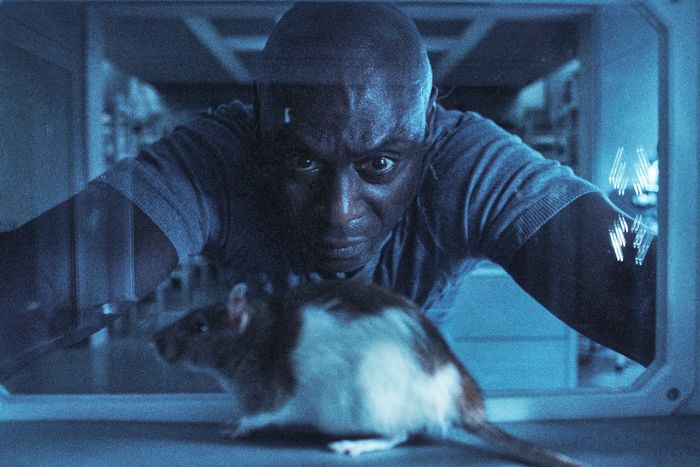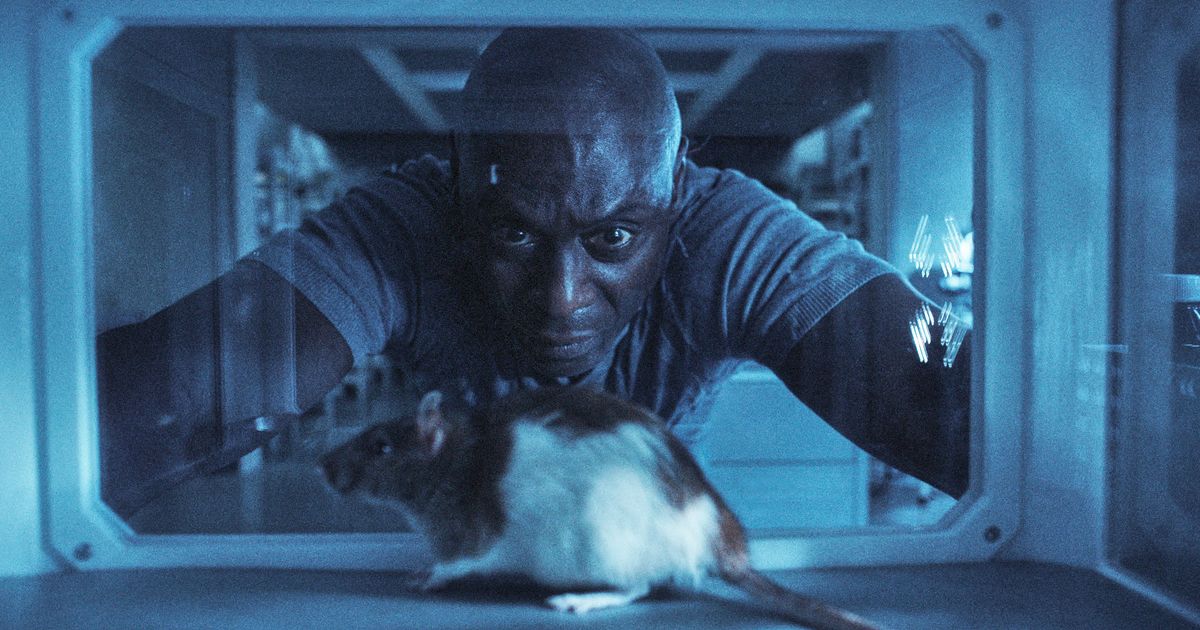
Photo: Netflix
There is a moment in the Netflix series adaptation of Resident Evil when Lance Reddick suddenly morphs into an action hero. While he’s kicking Umbrella operative butt in the alley behind an Olive Garden, twin teen protagonists Jade (Tamara Smart) and Billie (Siena Agudong) hide from the melee, but can’t stop themselves from watching. Mid-fight, Reddick looks directly at the camera, which is aligned with the girls, and sends them and us an exaggerated wink and a goofy grin. From The Wire to the John Wick franchise, Reddick has always radiated an aura of no-nonsense toughness, but for those few seconds, he goes gloriously against type.
This moment embodies a silliness that Resident Evil needs more of, because in spite of Reddick’s best efforts, this reboot of the long-running horror franchise is plagued by some of the most frustrating storytelling choices currently spreading throughout TV: constant jumping back and forth across a split timeline; “strong female characters” who often lack interiority; a padded episode count that causes the narrative to sag in the middle. When Resident Evil attempts to be serious, hard-edged sci-fi (which is often), it’s indistinguishable from all the other zombie-related content out there, probably because so much of the genre in the last few decades has been shaped, intentionally or not, by the undead aesthetic introduced in the first Japanese video game in 1996. Once you’ve seen one bloodthirsty undead ripping into a body-armored commando’s abdomen to pull out his intestines and eat them, you’ve seen them all! But when the series honors the franchise’s pulpy origins by incorporating various deep-cut video-game elements, Resident Evil actually feels like a shift away from the 20-year film franchise into new horror territory. It’s just unfortunate that those scenes are so few and far between.
Resident Evil’s eight-episode first season, which debuts on Netflix today, begins with an array of recognizable elements for both game and movie fans. As is often the case with an established property, showrunner, executive producer, and writer Andrew Dabb is tasked with finding a balance between what Resident Evil was and what it could be, and to do so, he puts a spin on established components. The pharma company Umbrella Corporation is still signified by a red umbrella and still up to no good, but this time around it’s peddling a miracle drug called Joy that is meant to combat depression, anxiety, and obsessive compulsive disorder. (Does the drug cause very troubling side effects? Of course!) The heroes are still women, but instead of Milla Jovovich’s often-cloned Alice or Kaya Scodelario’s Claire Redfield, they’re high-schoolers Jade Wesker (Smart) and Billie Wesker (Agudong), who in 2022 move to New Raccoon City with their father, Albert Wesker (Reddick), who works for Umbrella. And while the apocalypse that is integral to the whole Resident Evil universe is only starting to go down in 2022, it’s fully underway in 2036, when we see an adult Jade (Ella Balinska) traveling around and collecting data on the zombies to try and find some kind of reversal, cure, or immunity.
That 2022 versus 2036 divide is probably Resident Evil’s greatest challenge, given that it locks the series’s characters into paths that deny viewers the pleasure of narrative immersion and legitimate surprise. Knowing that Jade is a warrior badass with awful decision-making skills in 2036 makes her impetuousness and self-doubt in 2022 less intriguing, since we know she’ll never really progress past her already-introduced strengths and weaknesses. Umbrella’s nefariousness in 2022 is a given, so the reveal in 2036 that they’re willing to use drones against their own employees if it also means massacring zombies isn’t the moral shock Resident Evil seems to think it is. The series lacks ongoing tension because we so quickly see what a world in ruins looks like, and even if you can already anticipate that alternate reality from experience watching any other zombie property, Resident Evil would have benefited from a linear format that let the Jade and Billie sister dynamic and Wesker’s complicated relationship with Umbrella CEO Evelyn Marcus (Paola Núñez) unfurl at their own pace.
That’s not to say that the 2022 storyline is without flaws of its own. A subplot about Billie getting bullied suffers from some truly hackneyed mean-girl dialogue, Evelyn’s character could have used some additional development past “business lady turned crazy from ambition,” and an effectively scary, well-staged chase sequence through Umbrella’s laboratories is awkwardly placed at the end of the season. But Smart, Agudong, and Reddick work very well together as a family beginning to fray as a result of so many secrets and betrayals, and it’s irritating that so many of their scenes are awkwardly cut away from so we can check back in with the 2036 storyline, where of course things are bad. Children are in danger! The Umbrella Corporation has yet another convoluted plan! Survivors are turning on each other all the time! Going back to those elements intermittently instead of uninterruptedly doesn’t make them any less predictable.
And yet, all of Resident Evil’s wildest, goriest moments are interspersed throughout the future, and they hint at the episodic possibilities if this series were more willing to deviate from the franchise’s overarching mythology. A gigantic infected caterpillar the size of an 18-wheeler is a nightmare straight out of creature features and an impressive early foe for adult Jade. A mutant reptile kept secret until the season’s final episodes opens up a whole new world of genetic tweaking. A character from 2022 reappears in 2036 as a grotesque automaton of themselves, performing an Ex Machina–like dance sequence that taps into body horror. A zombie “queen,” her sore-covered face an impressive bit of makeup design, is able to communicate with her followers through shrill, unsettling screams, suggesting that strategizing zombies — a more serious foe! — aren’t out of the question. This is all slightly silly genre stuff, but Resident Evil doesn’t need to be serious. The series is better when it steps out from under the Umbrella instead of staying under it.



